Kids Have It Right
Kids seriously have it right. Especially the younger ones. While us adults are walking around planet Earth, worried about all the what ifs, deep emotions related to what someone said last Monday about the way our hair sat, kids are just solid in that particular moment. Playing with dolls, nothing else exists in the world. Building a sand castle, the only additional thought is if it’s Princess Elsa, or Princess Rapunzel living inside.
Oh, and one of my favorite parts of kids is the whole redirection deal. They will be completely mortified that they can’t have mac and cheese for dinner, but then you remind them about the action figure in the living room and there are no cares in the world. We adults get cut off on the highway and it ruins the next few minutes/hours of our day. Sometimes it even goes beyond that.
Somewhere in the mix of childhood to adulthood, we become conditioned away from letting things go and into letting things eat us up, A LOT. Somewhere in this mix, we allow ourselves to become distracted with negative emotions rather than just paying attention to what we’re doing in that moment. And somewhere in this mix, we feel such strong emotion that we begin to use activities as a way of distraction from our emotions rather than participating in an activity because it brings us joy.
So I guess I’m challenging you to take the mind of a child. When you’re doing something, do that. When you’re struggling with emotion, maybe sit with it and see if it’s something that’s truly worth contemplating some future action, or realize that, yeah that dude cut you off and all, and maybe it wasn’t super cool, but you’re ok, he’s ok, so let’s keep it moving. And if it is something that needs your attention (maybe a relationship issue, or a career change), take action. When we start moving in a direction of movement, we undoubtedly feel better because when not allowing it to fester.
Hope you have a kick ass day!










